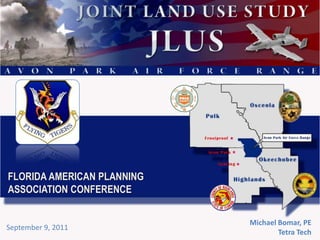9/9 FRI 4:15 | Avon Park AFR: Joint Land Use Study 2
- 1. FLORIDA AMERICAN PLANNING ASSOCIATION CONFERENCEMichael Bomar, PETetra TechSeptember 9, 2011
- 2. APPROACHIDENTIFY ISSUES FOR EACH JURISDICTIONDEVELOP POTENTIALSTRATEGIESPROVIDE JLUS RECOMMENDATIONS
- 4. IDENTIFY ISSUES FOR EACH JURISDICTIONDEVELOP POTENTIALSTRATEGIESPROVIDE JLUS RECOMMENDATIONSHighlands CountyAvon ParkSebringOkeechobee CountyOsceola CountyPolk CountyFrostproofAPAFRDesign & Construction Standards
- 7. Educational Handouts on Radio Frequency
- 9. Implement Sound Attenuation Construction Requirements
- 10. Identify Military Operations Areas on Public Documents
- 11. Military Influence Planning Area (MIPA) Ordinance
- 13. Comprehensive Plan & Land Development Code Updates
- 14. Military and Inter-Governmental Coordination
- 16. Airspace Studies
- 17. Designate Specific Use Restrictions to Maintain Compatibility
- 18. Voluntary Land or Development Rights Acquisition Program
- 20. Site Specific R/AICUZ for APAFR
- 21. Types of Development Near APAFR Boundary
- 22. Military Operations Areas (MOAs)
- 23. Aircraft Noise
- 24. Blast Noise Intensity & Frequency
- 25. Low Level Flight Area
- 26. Outdoor Lighting-Night Vision Goggle Training
- 27. Bird / Aircraft Strike Hazard (BASH)
- 29. Transportation Corridors & Study Areas
- 31. General Aviation & Military Aircraft ConflictsINTEGRATED ROLESAPAFR JLUSPublic JLUS Technical Working GroupJLUS Policy Committee
- 39. NOISE
- 40. LAND USE
- 41. COORDINATION
- 42. FLORIDA AMERICAN PLANNING ASSOCIATION CONFERENCEMichael Bomar, PETetra TechSeptember 9, 2011
- 43. RECOMMENDATIONS
- 45. MILITARY INFLUENCE PLANNING AREAS (MIPAs)MIPA-I:Focused on addressing compatibility issues in a three mile buffer zone around the perimeter of the Range and those areas where a moderate risk of blast noise complaints occur. It also includes a portion of low level flight training areas and areas where night vision training is conducted. MIPA-I’s are focused on limiting density, object height, and nighttime light encroachment. The designation of MIPA-I’s are not recommended for all jurisdictions participating in this study.
- 46. MIPA-II: Identified to address compatibility issues related to blast noise, low level flight training and areas where night vision training is conducted. MIPA-II’s are focused on limiting density, object height, and nighttime light encroachment. MIPA-II designations are not recommended for all jurisdictions participating in this study.
- 47. MIPA-III: Related to Areas of low risk of blast noise complaints, the presence of civilian aircraft operations and this area’s general proximity to MIPA’s I and II. The distance beyond the Range boundary for MIPA-III’s vary but the MIPA-III areas generally exist in the low level of blast noise risk areas outside MIPA’s I and II.

















